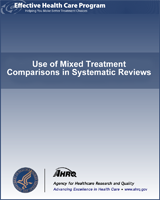Use of Mixed Treatment Comparisons in Systematic Reviews
Methods Research Reports
Authors
Investigators: Craig I Coleman, PharmD, Olivia J Phung, PharmD, Joseph C Cappelleri, PhD, MPH, MS, William L Baker, PharmD, BCPS, Jeffrey Kluger, MD, FACC, C Michael White, PharmD, FCP, FCCP, and Diana M Sobieraj, PharmD.Affiliations
Structured Abstract
Objectives:
To summarize publically available guidance for, and current use of, meta-analytic methods for mixed treatment comparison (MTC) evidence synthesis; to identify analyses using these methods and summarize their characteristics; to gain insight regarding the rationale for selection, implementation, and reporting of such methods from investigators.
Methods:
In part one, we identified currently available guidance documents addressing the use of MTC in evidence synthesis by searching governmental agencies' and participating members' of the International Network of Agencies for Health Technology Assessment Web sites. Commonalities and disagreements among guidance documents were summarized qualitatively. Next, in part two, a systematic literature search for MTCs was undertaken. Characteristics of included analysis were summarized qualitatively. Last, in part three, we invited a random selection of nine investigators from the systematic literature search to participate in a focus group. Using a Web-based series of questions, we queried respondents regarding their opinion of network meta-analysis and how elements of MTC methodology were chosen in their identified analysis. Responses were summarized qualitatively.
Results:
Guidance documents were typically written in a fashion to be applicable to network meta-analysis in general and not to a specific methodology. Guidance documents stressed Bayesian and Frequentist MTC approaches have strengths and limitations, while only one guidance document attempted to comprehensively address how to conduct a network meta-analysis and how to interpret and report results.
Our systematic review identified 42 MTCs of which the majority used Bayesian methods (80.9 percent). Bayesian analyses either used noninformative priors or did not report detail about priors used. Data regarding the evaluation of convergence, heterogeneity, and inconsistency were not consistently reported, and from those providing detail, it appears a broad range of methods were used.
Due to the infrequent use of Frequentist methods for MTC and poor response rate to our focus group invitation, all respondents had conducted a MTC using Bayesian methods. Consequently, we were unable to compare/contrast the viewpoints of investigators who used these two different methods.
Conclusion:
Additional guidance on how and when to conduct a MTC, as well as how to interpret and report results is needed. Published meta-analyses using these methods varied in how they conducted and reported results.
Prepared for: Agency for Healthcare Research and Quality, U.S. Department of Health and Human Services1, Contract No. 290-2007-10067-I. Prepared by: University of Connecticut/Hartford Hospital Evidence-based Practice Center, Hartford, CT
Suggested citation:
Coleman CI, Phung OJ, Cappelleri JC, Baker WL, Kluger J, White CM, Sobieraj DM. Use of Mixed Treatment Comparisons in Systematic Reviews. Methods Research Report. (Prepared by the University of Connecticut/Hartford Hospital Evidence-based Practice Center under Contract No. 290-2007-10067-I.) AHRQ Publication No. 12-EHC119-EF. Rockville, MD: Agency for Healthcare Research and Quality. August 2012. www.effectivehealthcare.ahrq.gov/reports/final.cfm.
This report is based on research conducted by the University of Connecticut/Hartford Hospital Evidence-based Practice Center (EPC) under contract to the Agency for Healthcare Research and Quality (AHRQ), Rockville, MD (Contract No. 290-2007-10067-I). The findings and conclusions in this document are those of the authors, who are responsible for its contents; the findings and conclusions do not necessarily represent the views of AHRQ. Therefore, no statement in this report should be construed as an official position of AHRQ or of the U.S. Department of Health and Human Services.
The information in this report is intended to help health care decisionmakers—patients and clinicians, health system leaders, and policymakers, among others—make well-informed decisions and thereby improve the quality of health care services. This report is not intended to be a substitute for the application of clinical judgment. Anyone who makes decisions concerning the provision of clinical care should consider this report in the same way as any medical reference and in conjunction with all other pertinent information, i.e., in the context of available resources and circumstances presented by individual patients.
This report may be used, in whole or in part, as the basis for development of clinical practice guidelines and other quality enhancement tools, or as a basis for reimbursement and coverage policies. AHRQ or U.S. Department of Health and Human Services endorsement of such derivative products may not be stated or implied.
None of the investigators have any affiliations or financial involvement that conflicts with the material presented in this report.
- 1
540 Gaither Road, Rockville, MD 20850; www
.ahrq.gov
